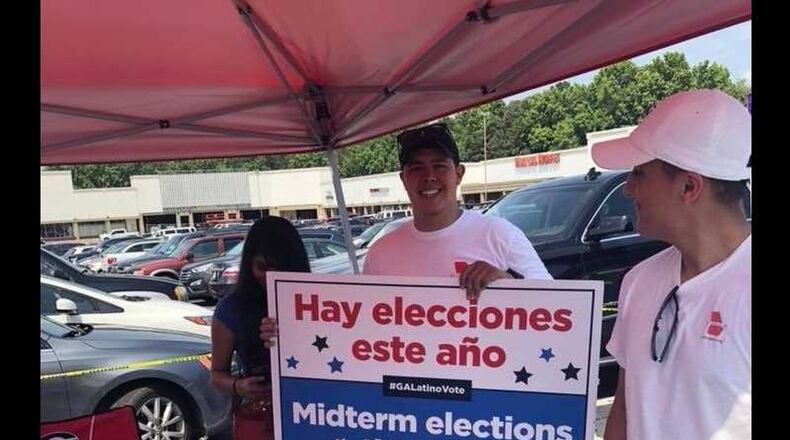University of Georgia student Elton García-Castillo said he worked three part-time jobs last semester, yet he still couldn’t afford the tuition.
He took out two loans to pay for school, totaling more than $8,000, and is already paying one back.
“There was no way I’m going to get (the tuition money) out of nowhere,” said García-Castillo, 22, a senior majoring in finance, explaining why he needed the loans.
For an increasing number of Georgia students, college is not only about learning and growing into adulthood, it’s about finding ways to afford it.
Needs-based aid for financially struggling students is a growing concern among many education analysts and public officials. There are about 525,000 students enrolled in Georgia's public and private colleges, and by some estimates, more than 10,000 of them drop out every year due to financial hardship. State lawmakers passed a bill on the final day of last year's legislative session aimed at filling the gap, but the final version of the legislation did not set aside a pot of money for students.
Credit: Branden Camp / Special
Credit: Branden Camp / Special
“If we’re really serious in the Georgia General Assembly about helping college students, we really need to be looking at needs-based scholarships,” said Sen. Lester Jackson, a Savannah Democrat who is exploring ideas about how to fund needs-based aid.
Jackson said the money could come from the sale of medical marijuana, which is under debate at the Legislature this session, or from taxes on casinos or pari mutuel betting, which the senator called "destination resorts." The chances of such legislation being passed this session are dicey, considering the aversion of many conservatives in the Republican-dominated state Legislature to both ideas.
State Sen. Lindsey Tippins, a Cobb County Republican who is the new chairman of the Higher Education Committee, said he’s open to some form of needs-based aid, as long as it’s affordable.
“If you’ve got (students) who are willing to work their tail off, I will help them,” Tippins said in his office one morning recently.
READ | College cost rises for Georgia’s poor
READ | Rising studen loan debt "crisis"
More Georgia students are relying on federal aid to attend college. The percentage of full-time University System of Georgia students who received Pell Grants, federal aid designed for students who fall under certain income eligibility levels, has increased from 34 percent to 44 percent over the last decade, state data shows.
After the Great Recession, college costs for many students rose at alarming rates while state support for each full-time student declined. Between fiscal year 2006 and 2015, the average cost of attendance at University System schools increased 77 percent from $8,361 to $14,791 per year, according to a report by the Georgia Department of Audits and Accounts. Meanwhile, state legislative support for college costs declined from 70 percent to about 50 percent during that time period.
The Georgia Board of Regents, at the recommendation of University System officials, voted last year not to raise tuition. The system is working on a new effort to better educate students about options to pay for college.
The state’s four largest public schools — Georgia State, the University of Georgia, Kennesaw State and Georgia Tech — each offer retention grants or scholarships to students with financial need. But many schools that serve high percentages of low-income students don’t have big names or alumni bases to raise money for scholarships, some experts say.
Georgia and New Hampshire are the only states without a funded needs-based aid program, according to the Education Commission of the States, a nonprofit. Money is typically the first or second reason why students drop out of college, research shows. Many of those dropouts could earn college degrees and work in local companies, particularly industries projected to have labor voids, says the Georgia Budget & Policy Institute, which has pushed for needs-based aid for several years. An estimated 112,000 students have a gap between the amount they receive in Pell Grants, student loans and jobs and the cost of their tuition, the institute says, citing University System data.
Nationwide, states award an average of $624 a year in needs-based aid per student, the institute said in a recent report, citing other research. If Georgia committed the national average per-student amount to University System students, the institute said it would cost $169 million a year. Gov. Brian Kemp’s proposed budget for the system is nearly $2.6 billion.
Jennifer Lee, the institute’s higher education policy analyst, said Georgia could offer grants or scholarships matching what students receive in federal Pell Grants. Another approach, she said, is to mimic a program used by the University of Colorado in which some students in need work at jobs funded by the federal and state government, on or off campus.
“A lot of these students have already demonstrated they want to be in school, so I think the question isn’t about will,” Lee said. “If the school is willing to enroll the student, there is a shared responsibility for the state to help students to graduate.”
UGA's García-Castillo is working one job this semester, in the university's parking services department. He said his grades initially dropped when he took on the extra work, including losing the HOPE Scholarship, but he isn't complaining about his situation.
García-Castillo is paying about $100 a month on one of his two loans.
“It would help,” he said of a needs-based aid program.
WHY IT MATTERS
By some estimates, more than 10,000 students drop out of Georgia colleges and universities every year because they cannot afford the tuition. An increasing number of Georgia students receive federal aid to attend college.
About the Author
Keep Reading
The Latest
Featured





